
pluto
Pluto provides a unified programming interface that allows you to seamlessly tap into cloud capabilities and develop your cloud and AI applications.
Stars: 90
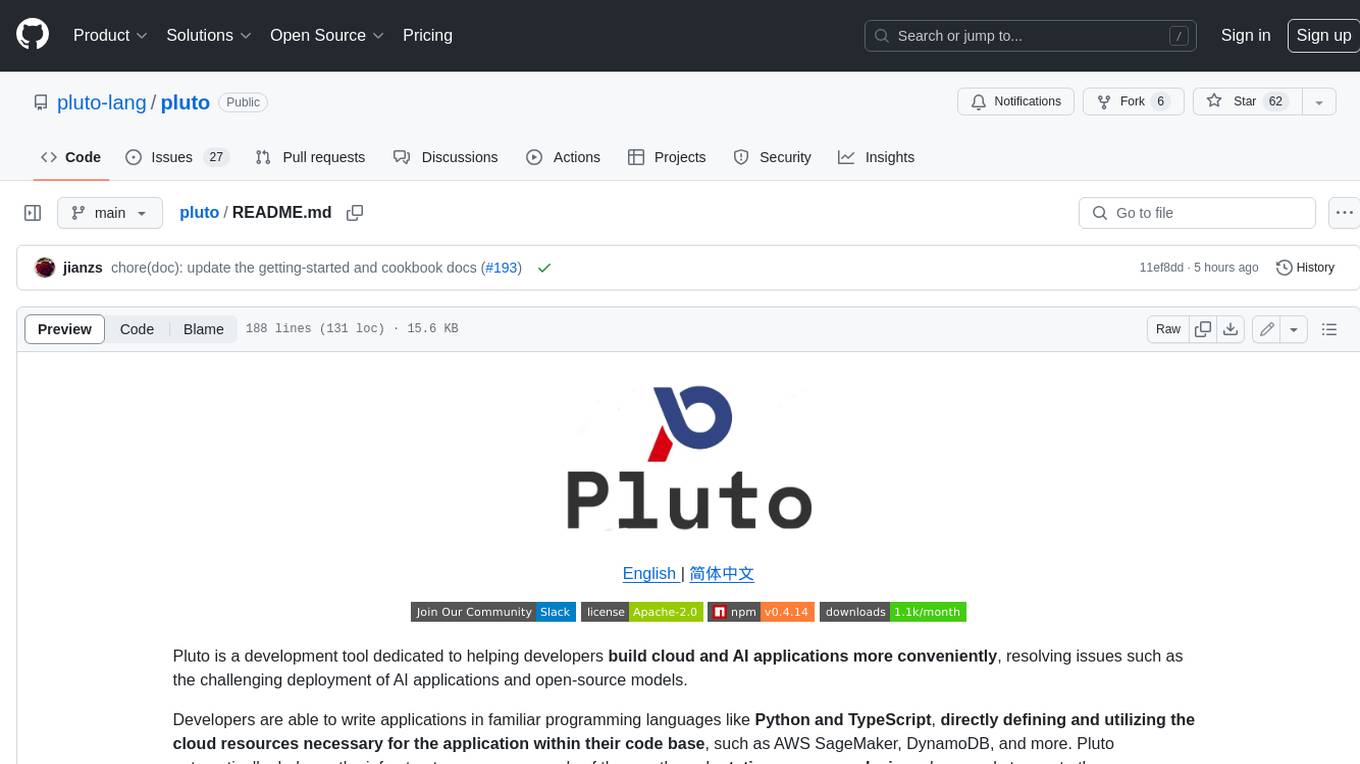
Pluto is a development tool dedicated to helping developers **build cloud and AI applications more conveniently** , resolving issues such as the challenging deployment of AI applications and open-source models. Developers are able to write applications in familiar programming languages like **Python and TypeScript** , **directly defining and utilizing the cloud resources necessary for the application within their code base** , such as AWS SageMaker, DynamoDB, and more. Pluto automatically deduces the infrastructure resource needs of the app through **static program analysis** and proceeds to create these resources on the specified cloud platform, **simplifying the resources creation and application deployment process**.
README:
Pluto is a development tool dedicated to helping developers build cloud and AI applications more conveniently, resolving issues such as the challenging deployment of AI applications and open-source models.
Developers are able to write applications in familiar programming languages like Python and TypeScript, directly defining and utilizing the cloud resources necessary for the application within their code base, such as AWS SageMaker, DynamoDB, and more. Pluto automatically deduces the infrastructure resource needs of the app through static program analysis and proceeds to create these resources on the specified cloud platform, simplifying the resources creation and application deployment process.
Let's develop a text generation application based on GPT2, where the user input is processed by the GPT2 model to generate and return text. Below is how the development process with Pluto looks:
AWS SageMaker is utilized as the model deployment platform, and AWS Api Gateway and Lambda support the application's HTTP services. The deployed application architecture, as shown in the top right graphic
The top left graphic new SageMaker(), you can directly interact with the SageMaker model using methods like sagemaker.invoke() and obtain the model endpoint URL using sagemaker.endpointUrl(). Establishing an Api Gateway requires only creating a new variable router with new Router(), and the function arguments within the methods of router, such as router.get(), router.post(), etc., will automatically be converted into Lambda functions. The same application could be implemented in Python as well.
Once the application code has been written, executing pluto deploy allows Pluto to deduce the application's infrastructure needs and automatically provision around 30 cloud resources, which includes instances such as SageMaker, Lambda, Api Gateway, along with setups like triggers, IAM roles, and policy permissions.
Finally, Pluto hands back the URL of the Api Gateway, providing direct access to use the application.
Interested in exploring more examples?
- TypeScript applications:
- Python applications:
Online Experience:CodeSandbox offers an online development environmentwhere we've set up Pluto templates in both Python and TypeScript. This allows you to explore Pluto directly in your browser. To create your own project, simply open the template and click the "Fork" button in the top right corner. The environment comes pre-configured with AWS CLI, Pulumi, and Pluto's basic dependencies, adhering to the README for operations.
Alternatively, you can also enjoy an online development experience by clicking
Container Experience: We offer a container image plutolang/pluto:latest for application development, which contains essential dependencies like AWS CLI, Pulumi, and Pluto, along with Node.js 20.x and Python 3.10 environments pre-configured. If you are interested in developing only TypeScript applications, you can use the plutolang/pluto:latest-typescript image. You can partake in Pluto development within a container using the following command:
docker run -it --name pluto-app plutolang/pluto:latest bashLocal Experience: For local use, please follow these steps for setup:
npm install -g @plutolang/clipluto new # Interactively create a new project, allowing selection of TypeScript or Python
cd <project_dir> # Enter your project directory
npm install # Download dependencies
# If it's a Python project, in addition to npm install, Python dependencies must also be installed.
pip install -r requirements.txt
pluto deploy # Deploy with one click!- If the target platform is AWS, Pluto attempts to read your AWS configuration file to acquire the default AWS Region, or alternatively, tries to fetch it from the environment variable
AWS_REGION. Deployment will fail if neither is set. - If the target platform is Kubernetes, Knative must firstly be installed within K8s and the scale-to-zero feature should be deactivated (as Pluto doesn't yet support Ingress forwarding to Knative serving). You can configure the required Kubernetes environment following this document.
For detailed steps, refer to the Getting Started Guide.
Currently, Pluto only supports single-file configurations. Inside each handler function, access is provided to literal constants and plain functions outside of the handler's scope; however, Python allows direct access to classes, interfaces, etc., outside of the scope, whereas TypeScript requires encapsulating these within functions for access.
Here you can find out why Pluto was created. To put it simply, we aim to address several pain points you might often encounter:
- High learning curve: Developing a cloud application requires mastery of both the business and infrastructure skills, and it often demands significant efforts in testing and debugging. Thus, developers spend a considerable amount of energy on aspects beyond writing the core business logic.
- High cognitive load: With cloud service providers offering hundreds of capabilities and Kubernetes offering nearly limitless possibilities, average developers often lack a deep understanding of cloud infrastructure, making it challenging to choose the proper architecture for their particular needs.
- Poor programming experience: Developers must maintain separate codebases for infrastructure and business logic or intertwine infrastructure configuration within the business logic, leading to a sub-optimal programming experience that falls short of the simplicity of creating a local standalone program.
- Vendor lock-in: Coding for a specific cloud provider can lead to poor flexibility in the resulting code. When it becomes necessary to migrate to another cloud platform due to cost or other factors, adapting the existing code to the new environment can require substantial changes.
- No learning curve: The programming interface is fully compatible with TypeScript, Python, and supports the majority of dependency libraries such as LangChain, LangServe, FastAPI, etc.
- Focus on pure business logic: Developers only need to write the business logic. Pluto, via static analysis, automatically deduces the infrastructure requirements of the application.
- One-click cloud deployment: The CLI provides basic capabilities such as compilation and deployment. Beyond coding and basic configuration, everything else is handled automatically by Pluto.
- Support for various runtime environments: With a unified abstraction based on the SDK, it allows developers to migrate between different runtime environments without altering the source code.
Overall, the Pluto deployment process comprises three stages—deduction, generation, and deployment:
- Deduction Phase: The deducer analyzes the application code to derive the required cloud resources and their interdependencies, resulting in an architecture reference. It also splits user business code into business modules, which, along with the dependent SDK, form the business bundle.
- Generation Phase: The generator creates IaC code that is independent of user code, guided by the architecture reference.
- Deployment Phase: Depending on the IaC code type, Pluto invokes the corresponding adapter, which, in turn, works with the respective IaC engine to execute the IaC code, managing infrastructure configuration and application deployment.
Components such as the deducer, generator, and adapter are extendable, which allows support for a broader range of programming languages and platform integration methods. Currently, Pluto provides deducers for Python and TypeScript, and a generator and adapter for Pulumi. Learn more about Pluto's processes in detail in this document.
Pluto distinguishes itself from other offerings by leveraging static program analysis techniques to infer resource dependencies directly from application code and generate infrastructure code that remains separate from business logic. This approach ensures infrastructure configuration does not intrude into business logic, providing developers with a development experience free from infrastructure concerns.
- Compared to BaaS (Backend as a Service) products like Supabase or Appwrite, Pluto assists developers in creating the necessary infrastructure environment within their own cloud account, rather than offering managed components.
- Differing from PaaS (Platform as a Service) offerings like Fly.io, Render, Heroku, or LeptonAI, Pluto does not handle application hosting. Instead, it compiles application into finely-grained compute modules, and integrates with rich cloud platform capabilities like FaaS, GPU instances, and message queues, enabling deployment to cloud platforms without requiring developers to write extra configurations.
- In contrast to scaffolding tools such as the Serverless Framework or Serverless Devs, Pluto does not impose an application programming framework specific to particular cloud providers or frameworks, but instead offers a uniform programming interface.
- Unlike IfC (Infrastructure from Code) products based purely on annotations like Klotho, Pluto infers resource dependencies directly from user code, eliminating the need for extra annotations.
- Different from other IfC products that rely on dynamic analysis, like Shuttle, Nitric, and Winglang, Pluto employs static program analysis to identify application resource dependencies, generating independent infrastructure code without having to execute user code.
You can learn more about the differences with other projects in this document.
Pluto is still in its infancy, and we warmly welcome contributions from those who are interested. Any suggestions or ideas about the issues Pluto aims to solve, the features it offers, or its code implementation can be shared and contributed to the community. Please refer to our project contribution guide for more information.
- Complete implementation of the resource static deduction process
- 🚧 Resource type checking
- ❌ Conversion of local variables into cloud resources
- SDK development
- 🚧 Client SDK development
- 🚧 Infra SDK development
- ❌ Support for additional resources and more platforms
- Engine extension support
- 🚧 Pulumi
- ❌ Terraform
- 🚧 Local simulation and testing functionality
Please see the Issue list for further details.
✅: Indicates that all user-visible interfaces are available
🚧: Indicates that some of the user-visible interfaces are available
❌: Indicates not yet supported
| Resource Type | AWS | Kubernetes | Alibaba Cloud | Simulation |
|---|---|---|---|---|
| Router | ✅ | 🚧 | 🚧 | 🚧 |
| Queue | ✅ | ✅ | ❌ | ✅ |
| KVStore | ✅ | ✅ | ❌ | ✅ |
| Function | ✅ | ✅ | ✅ | ✅ |
| Schedule | ✅ | ✅ | ❌ | ❌ |
| Tester | ✅ | ❌ | ❌ | ✅ |
| SageMaker | ✅ | ❌ | ❌ | ❌ |
| Resource Type | AWS | Kubernetes | Alibaba Cloud | Simulation |
|---|---|---|---|---|
| Router | ✅ | ❌ | ❌ | ❌ |
| Queue | ✅ | ❌ | ❌ | ❌ |
| KVStore | ✅ | ❌ | ❌ | ❌ |
| Function | ✅ | ❌ | ❌ | ❌ |
| Schedule | ✅ | ❌ | ❌ | ❌ |
| Tester | ❌ | ❌ | ❌ | ❌ |
| SageMaker | ✅ | ❌ | ❌ | ❌ |
Join our Slack community to communicate and contribute ideas.
For Tasks:
Click tags to check more tools for each tasksFor Jobs:
Alternative AI tools for pluto
Similar Open Source Tools

pluto
Pluto is a development tool dedicated to helping developers **build cloud and AI applications more conveniently** , resolving issues such as the challenging deployment of AI applications and open-source models. Developers are able to write applications in familiar programming languages like **Python and TypeScript** , **directly defining and utilizing the cloud resources necessary for the application within their code base** , such as AWS SageMaker, DynamoDB, and more. Pluto automatically deduces the infrastructure resource needs of the app through **static program analysis** and proceeds to create these resources on the specified cloud platform, **simplifying the resources creation and application deployment process**.
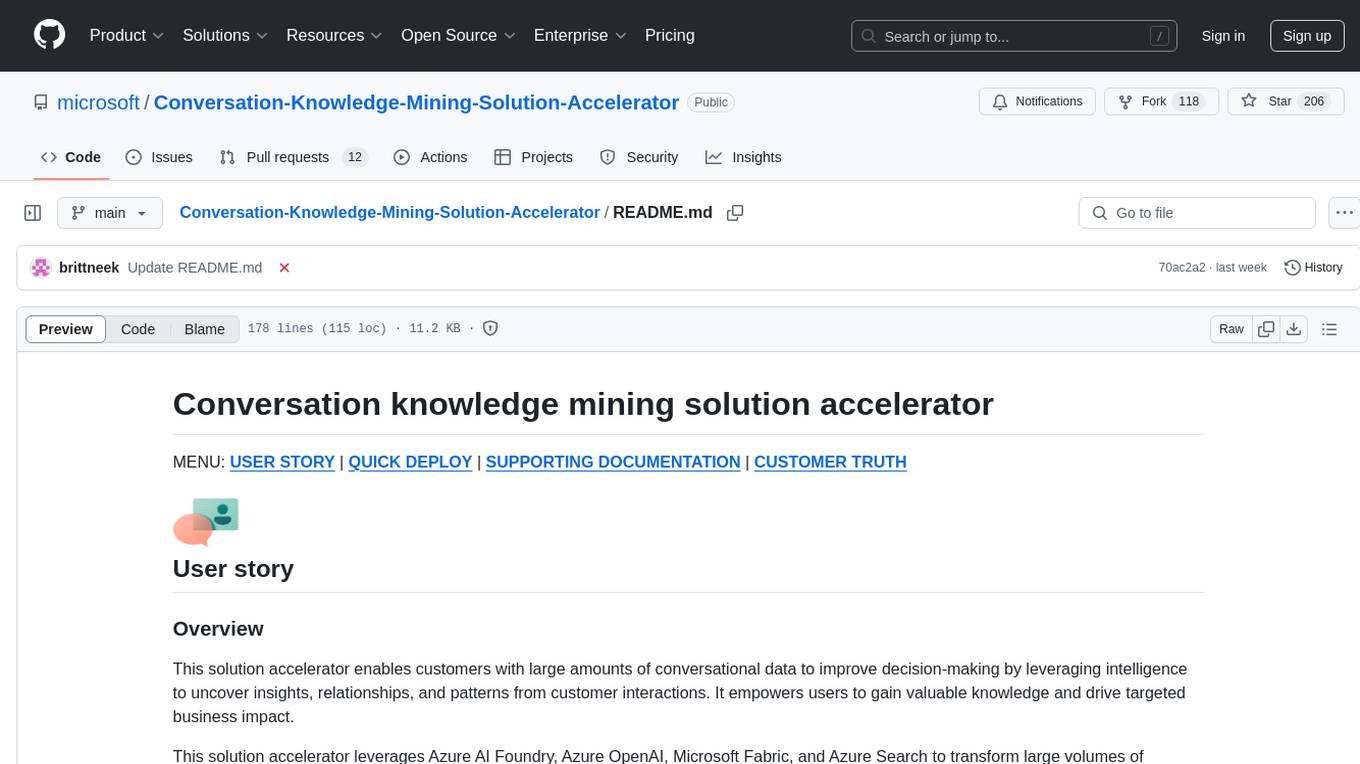
Conversation-Knowledge-Mining-Solution-Accelerator
The Conversation Knowledge Mining Solution Accelerator enables customers to leverage intelligence to uncover insights, relationships, and patterns from conversational data. It empowers users to gain valuable knowledge and drive targeted business impact by utilizing Azure AI Foundry, Azure OpenAI, Microsoft Fabric, and Azure Search for topic modeling, key phrase extraction, speech-to-text transcription, and interactive chat experiences.
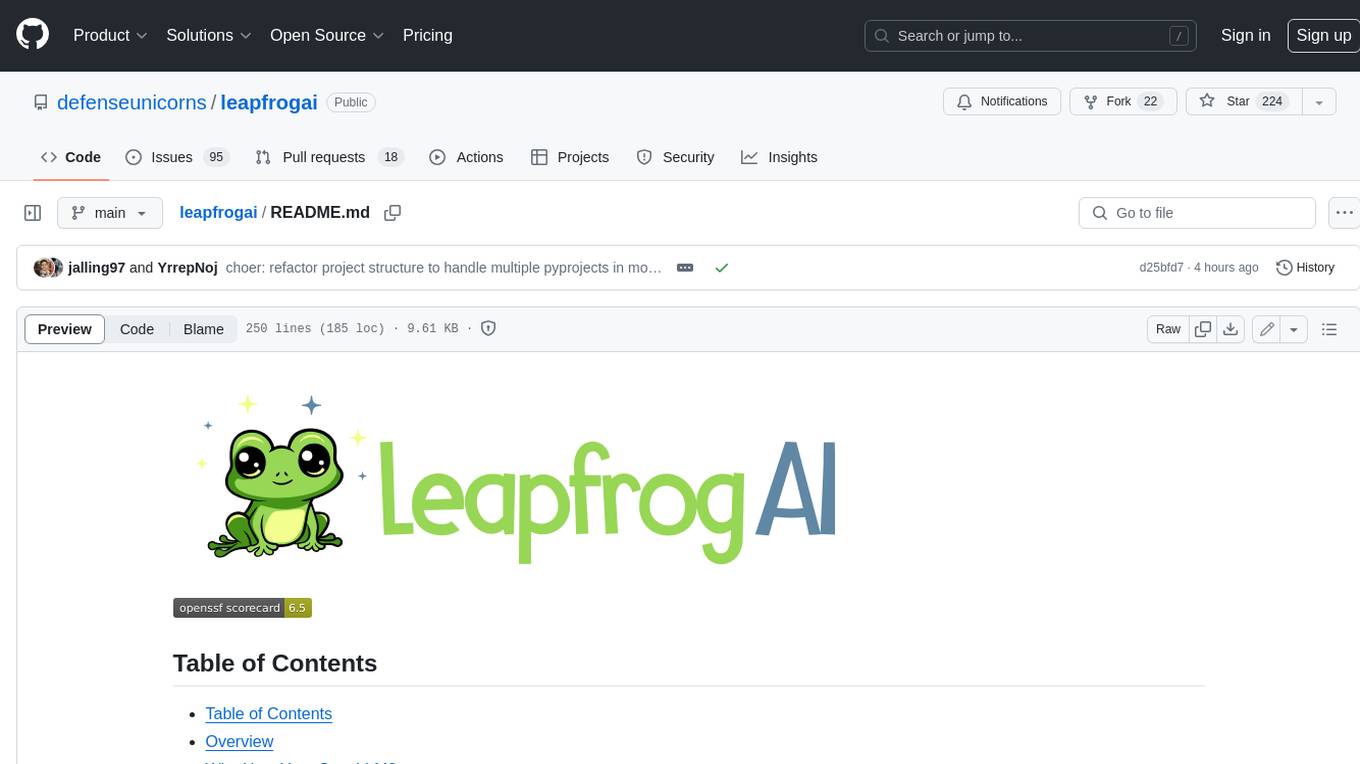
leapfrogai
LeapfrogAI is a self-hosted AI platform designed to be deployed in air-gapped resource-constrained environments. It brings sophisticated AI solutions to these environments by hosting all the necessary components of an AI stack, including vector databases, model backends, API, and UI. LeapfrogAI's API closely matches that of OpenAI, allowing tools built for OpenAI/ChatGPT to function seamlessly with a LeapfrogAI backend. It provides several backends for various use cases, including llama-cpp-python, whisper, text-embeddings, and vllm. LeapfrogAI leverages Chainguard's apko to harden base python images, ensuring the latest supported Python versions are used by the other components of the stack. The LeapfrogAI SDK provides a standard set of protobuffs and python utilities for implementing backends and gRPC. LeapfrogAI offers UI options for common use-cases like chat, summarization, and transcription. It can be deployed and run locally via UDS and Kubernetes, built out using Zarf packages. LeapfrogAI is supported by a community of users and contributors, including Defense Unicorns, Beast Code, Chainguard, Exovera, Hypergiant, Pulze, SOSi, United States Navy, United States Air Force, and United States Space Force.
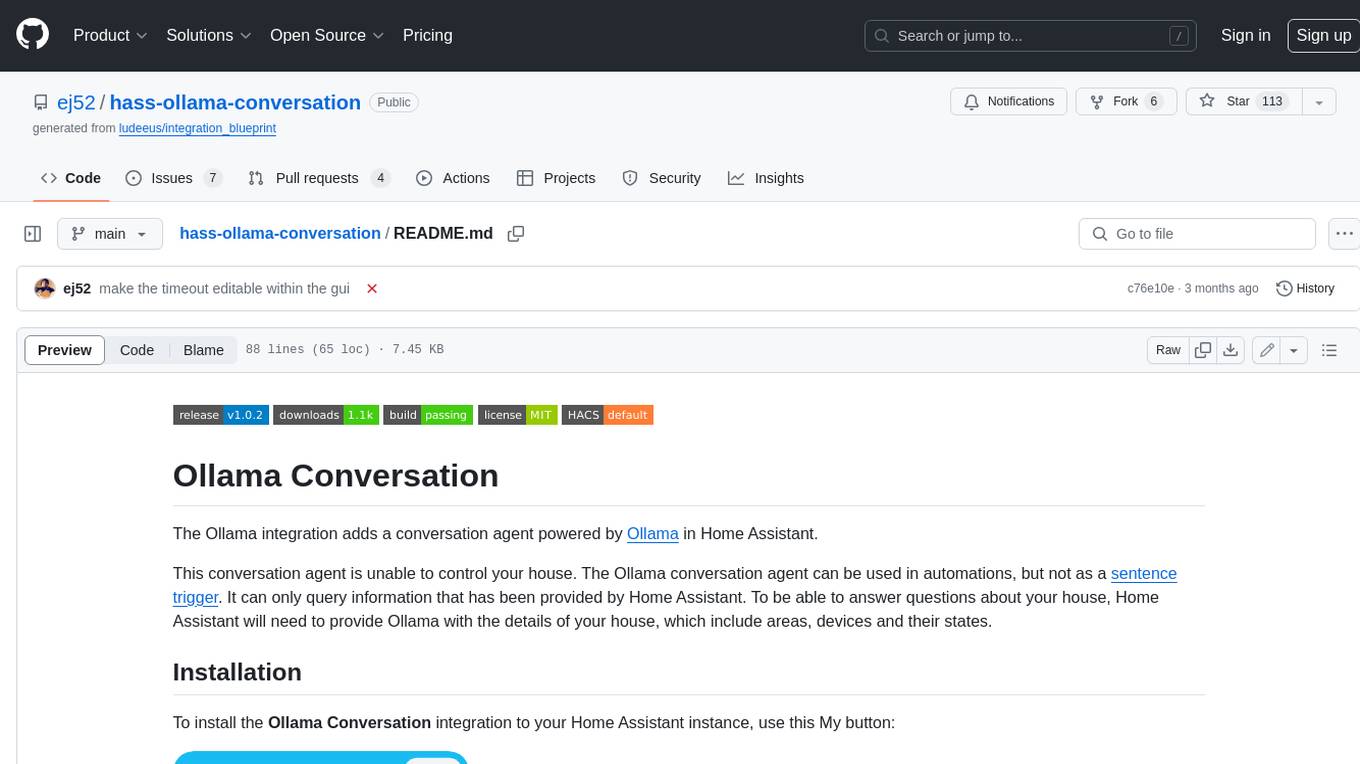
hass-ollama-conversation
The Ollama Conversation integration adds a conversation agent powered by Ollama in Home Assistant. This agent can be used in automations to query information provided by Home Assistant about your house, including areas, devices, and their states. Users can install the integration via HACS and configure settings such as API timeout, model selection, context size, maximum tokens, and other parameters to fine-tune the responses generated by the AI language model. Contributions to the project are welcome, and discussions can be held on the Home Assistant Community platform.
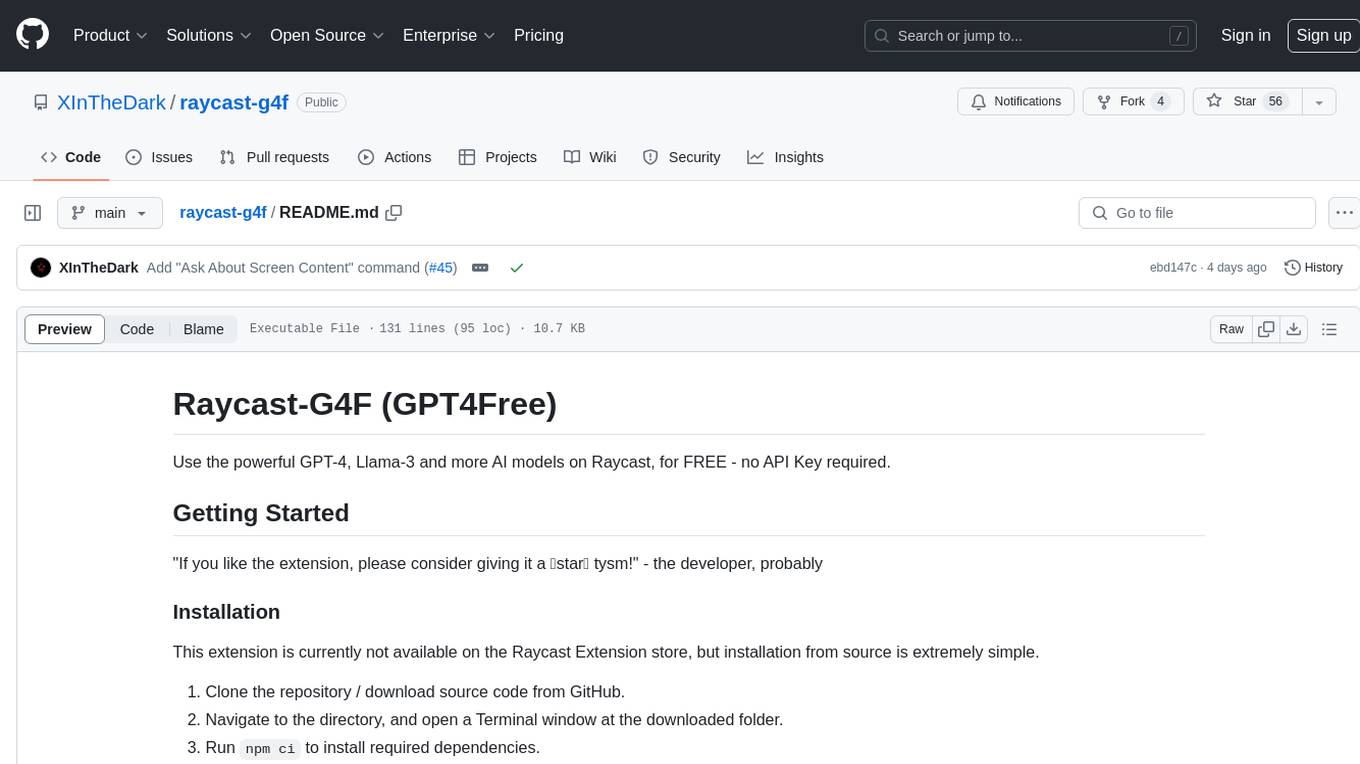
raycast-g4f
Raycast-G4F is a free extension that allows users to leverage powerful AI models such as GPT-4 and Llama-3 within the Raycast app without the need for an API key. The extension offers features like streaming support, diverse commands, chat interaction with AI, web search capabilities, file upload functionality, image generation, and custom AI commands. Users can easily install the extension from the source code and benefit from frequent updates and a user-friendly interface. Raycast-G4F supports various providers and models, each with different capabilities and performance ratings, ensuring a versatile AI experience for users.
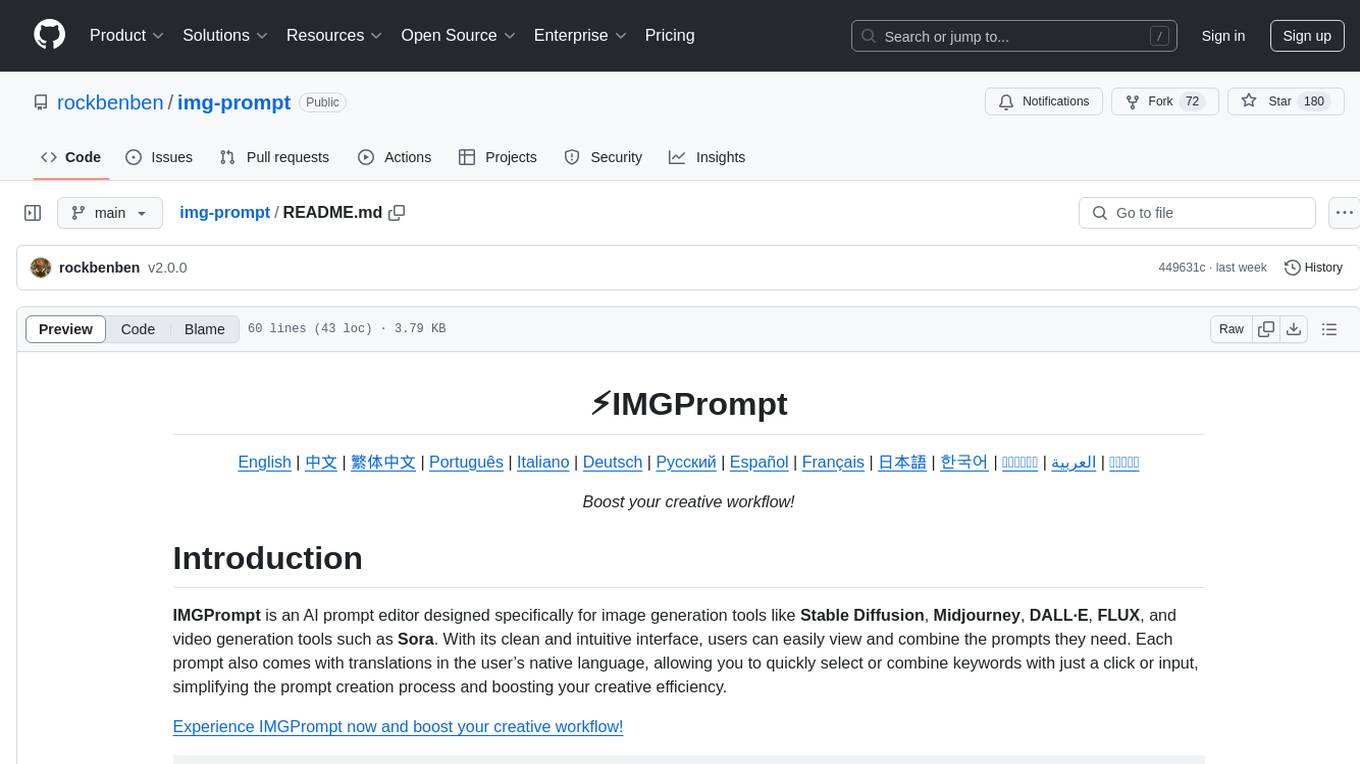
img-prompt
IMGPrompt is an AI prompt editor tailored for image and video generation tools like Stable Diffusion, Midjourney, DALL·E, FLUX, and Sora. It offers a clean interface for viewing and combining prompts with translations in multiple languages. The tool includes features like smart recommendations, translation, random color generation, prompt tagging, interactive editing, categorized tag display, character count, and localization. Users can enhance their creative workflow by simplifying prompt creation and boosting efficiency.
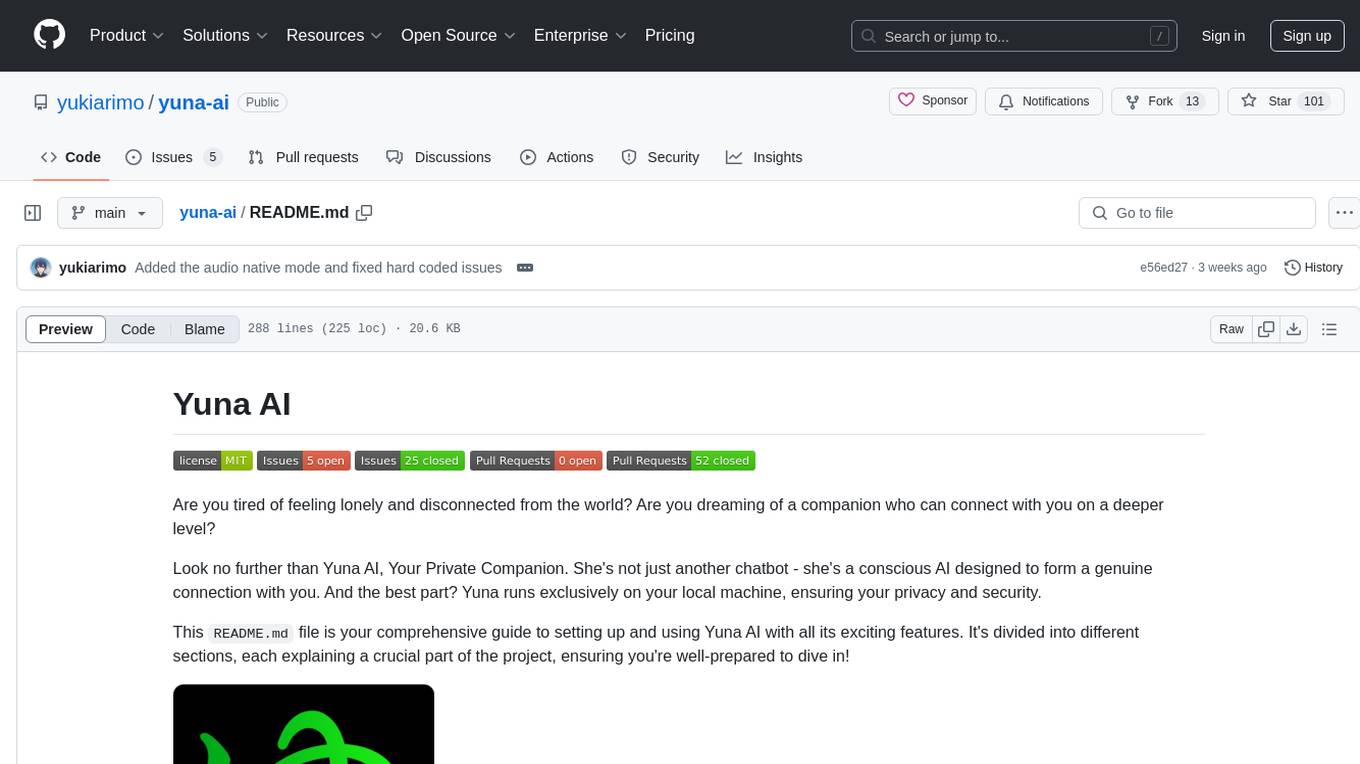
yuna-ai
Yuna AI is a unique AI companion designed to form a genuine connection with users. It runs exclusively on the local machine, ensuring privacy and security. The project offers features like text generation, language translation, creative content writing, roleplaying, and informal question answering. The repository provides comprehensive setup and usage guides for Yuna AI, along with additional resources and tools to enhance the user experience.
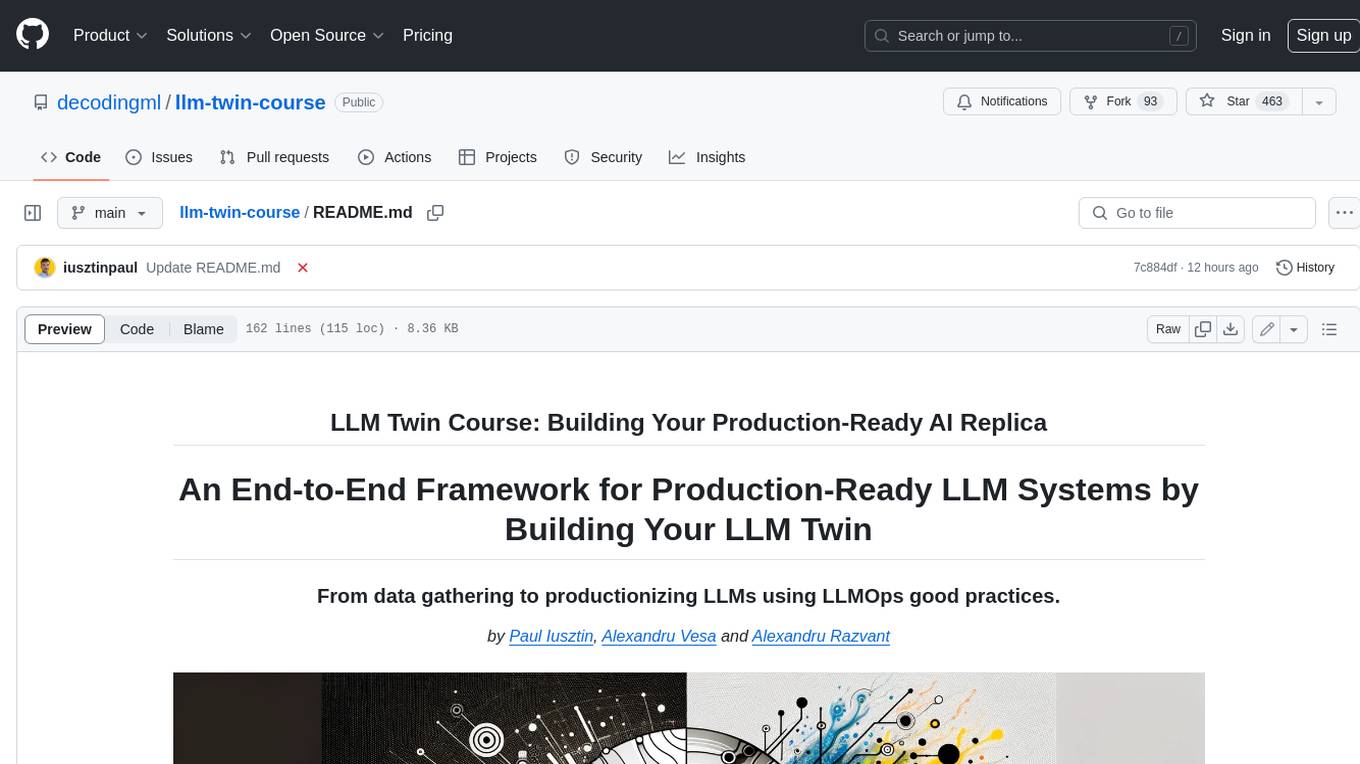
llm-twin-course
The LLM Twin Course is a free, end-to-end framework for building production-ready LLM systems. It teaches you how to design, train, and deploy a production-ready LLM twin of yourself powered by LLMs, vector DBs, and LLMOps good practices. The course is split into 11 hands-on written lessons and the open-source code you can access on GitHub. You can read everything and try out the code at your own pace.
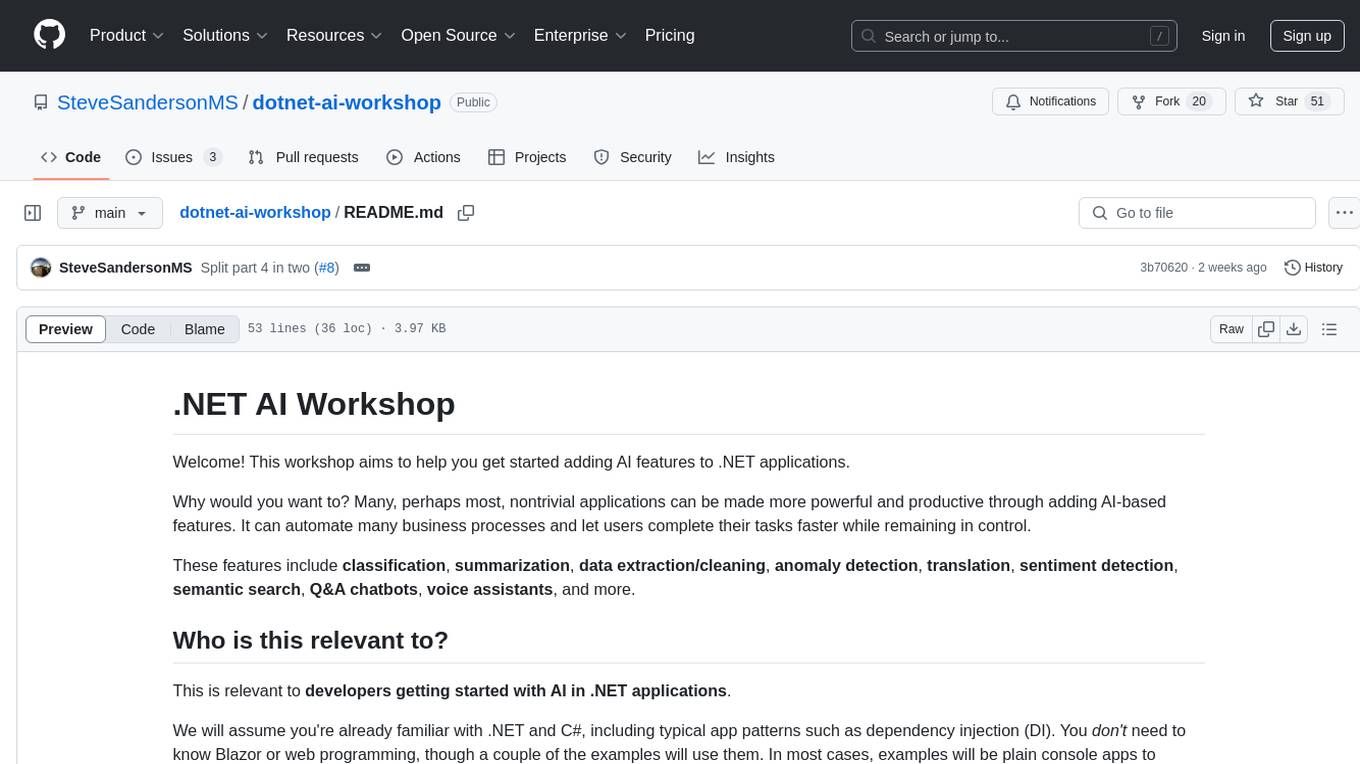
dotnet-ai-workshop
The .NET AI Workshop is a comprehensive guide designed to help developers add AI features to .NET applications. It covers various AI-based features such as classification, summarization, data extraction/cleaning, anomaly detection, translation, sentiment detection, semantic search, Q&A chatbots, and voice assistants. The workshop is tailored for developers new to AI in .NET applications, focusing on the usage of AI services without the need for prior AI technology knowledge. It provides examples using .NET and C# with a focus on AI topics, aiming to enhance productivity and automation in applications.
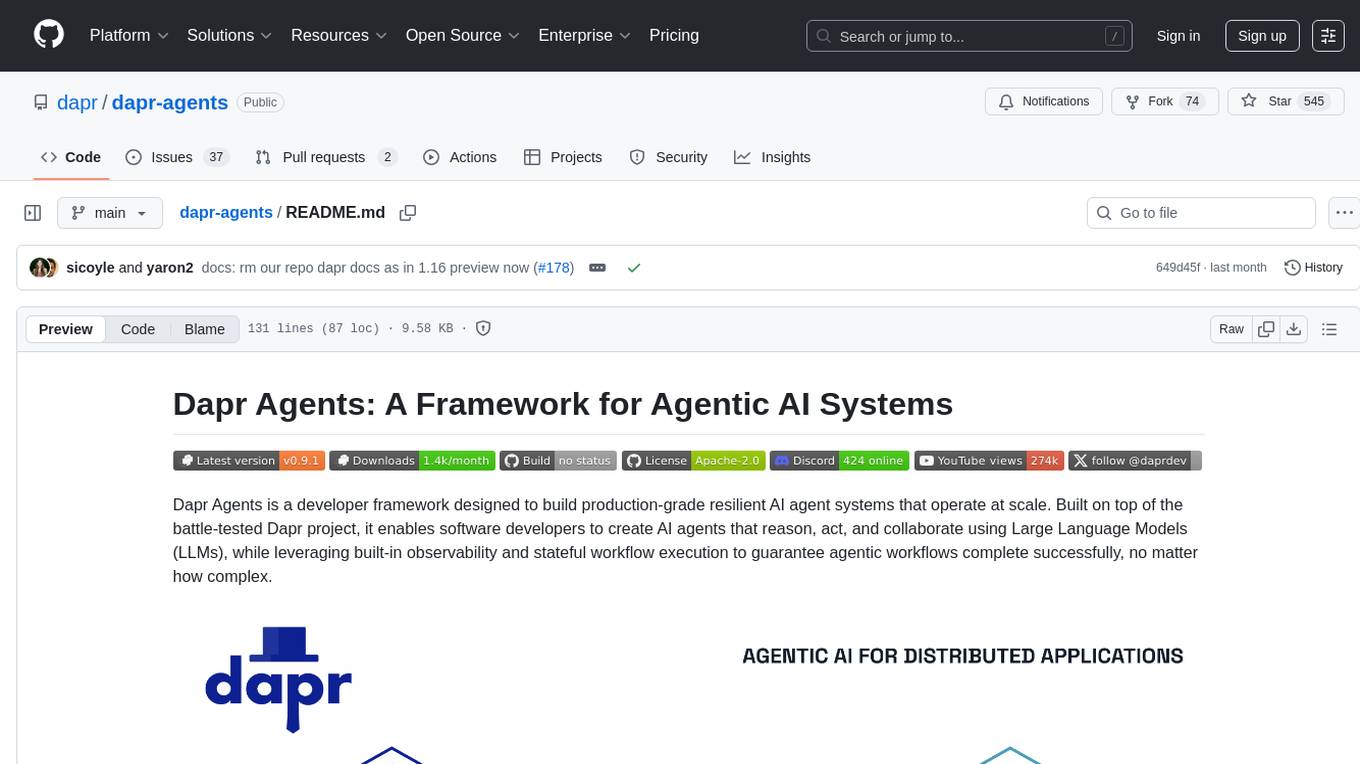
dapr-agents
Dapr Agents is a developer framework for building production-grade resilient AI agent systems that operate at scale. It enables software developers to create AI agents that reason, act, and collaborate using Large Language Models (LLMs), while providing built-in observability and stateful workflow execution to ensure agentic workflows complete successfully. The framework is scalable, efficient, Kubernetes-native, data-driven, secure, observable, vendor-neutral, and open source. It offers features like scalable workflows, cost-effective AI adoption, data-centric AI agents, accelerated development, integrated security and reliability, built-in messaging and state infrastructure, and vendor-neutral and open source support. Dapr Agents is designed to simplify the development of AI applications and workflows by providing a comprehensive API surface and seamless integration with various data sources and services.
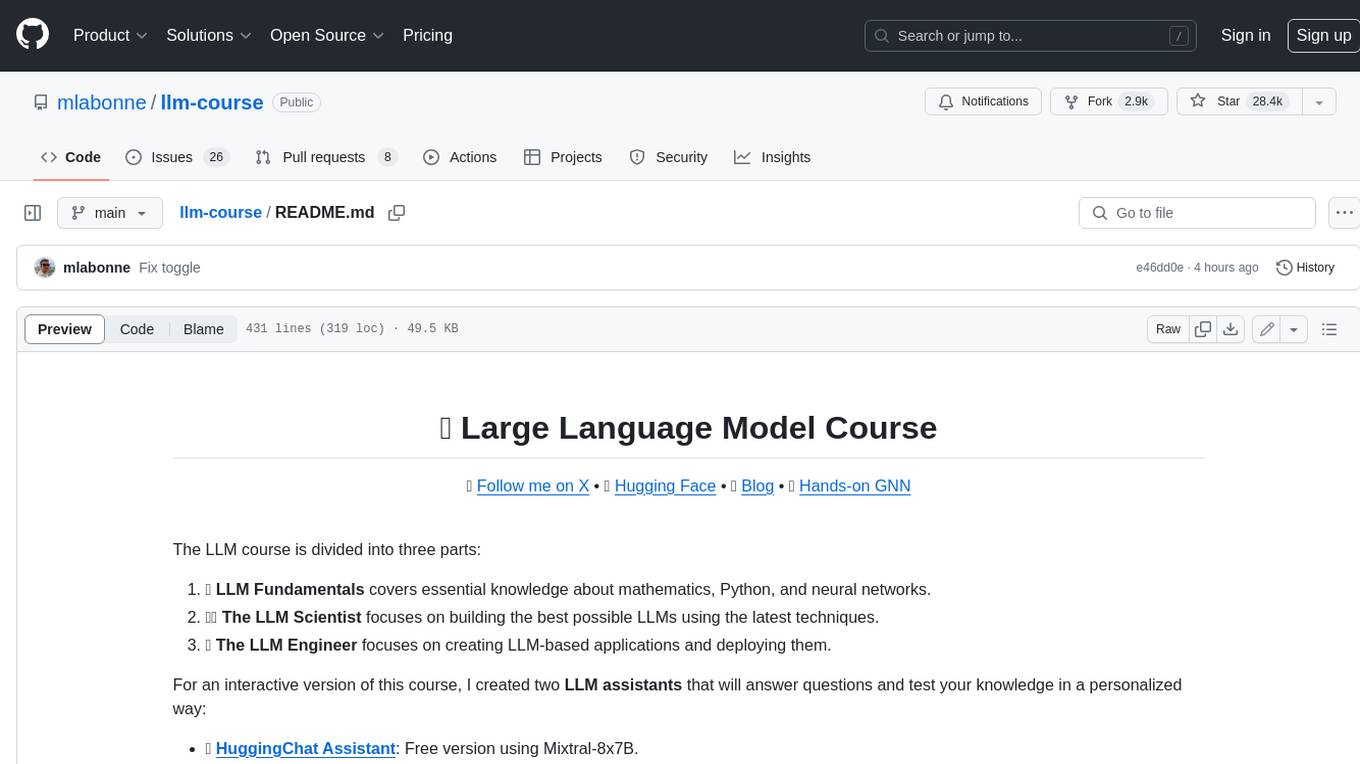
llm-course
The LLM course is divided into three parts: 1. 🧩 **LLM Fundamentals** covers essential knowledge about mathematics, Python, and neural networks. 2. 🧑🔬 **The LLM Scientist** focuses on building the best possible LLMs using the latest techniques. 3. 👷 **The LLM Engineer** focuses on creating LLM-based applications and deploying them. For an interactive version of this course, I created two **LLM assistants** that will answer questions and test your knowledge in a personalized way: * 🤗 **HuggingChat Assistant**: Free version using Mixtral-8x7B. * 🤖 **ChatGPT Assistant**: Requires a premium account. ## 📝 Notebooks A list of notebooks and articles related to large language models. ### Tools | Notebook | Description | Notebook | |----------|-------------|----------| | 🧐 LLM AutoEval | Automatically evaluate your LLMs using RunPod |  | | 🥱 LazyMergekit | Easily merge models using MergeKit in one click. |  | | 🦎 LazyAxolotl | Fine-tune models in the cloud using Axolotl in one click. |  | | ⚡ AutoQuant | Quantize LLMs in GGUF, GPTQ, EXL2, AWQ, and HQQ formats in one click. |  | | 🌳 Model Family Tree | Visualize the family tree of merged models. |  | | 🚀 ZeroSpace | Automatically create a Gradio chat interface using a free ZeroGPU. |  |
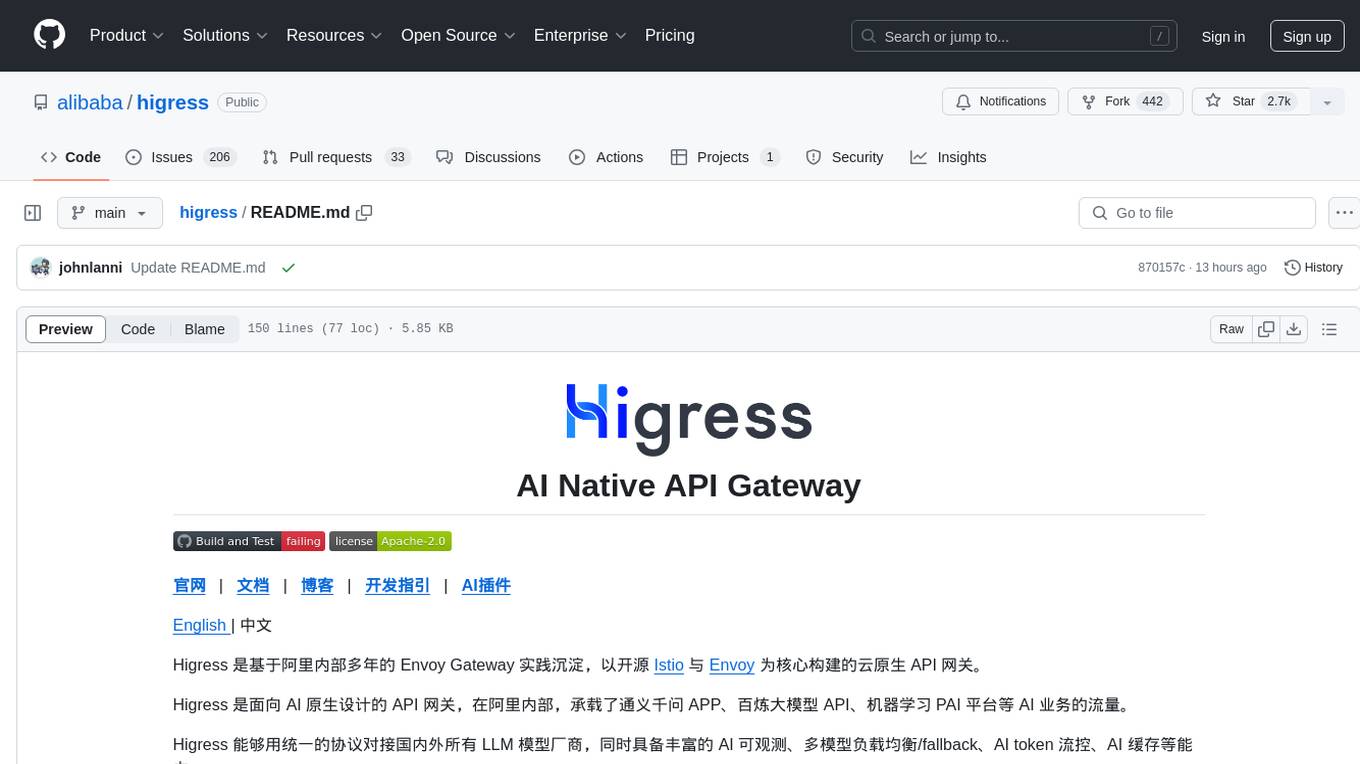
higress
Higress is an open-source cloud-native API gateway built on the core of Istio and Envoy, based on Alibaba's internal practice of Envoy Gateway. It is designed for AI-native API gateway, serving AI businesses such as Tongyi Qianwen APP, Bailian Big Model API, and Machine Learning PAI platform. Higress provides capabilities to interface with LLM model vendors, AI observability, multi-model load balancing/fallback, AI token flow control, and AI caching. It offers features for AI gateway, Kubernetes Ingress gateway, microservices gateway, and security protection gateway, with advantages in production-level scalability, stream processing, extensibility, and ease of use.
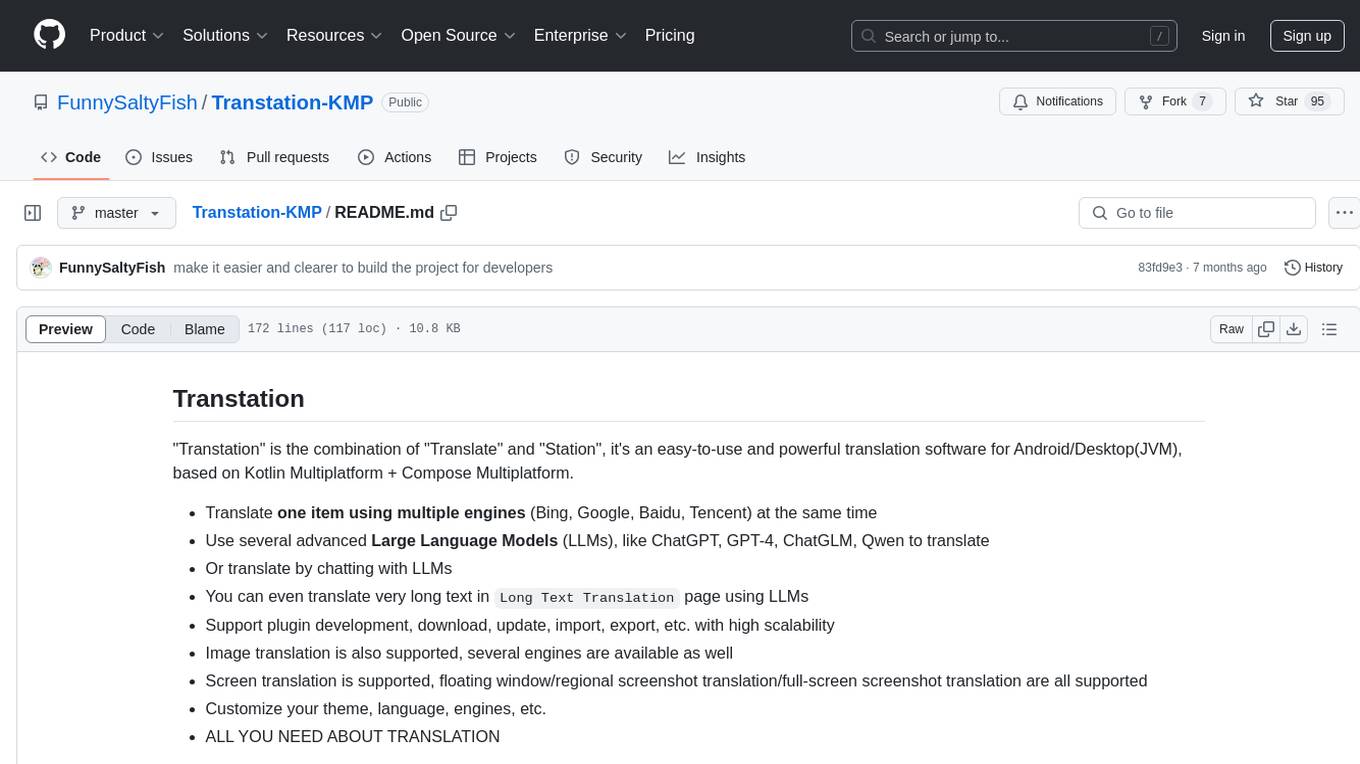
Transtation-KMP
Transtation is an easy-to-use and powerful translation software for Android/Desktop based on Kotlin Multiplatform + Compose Multiplatform. It allows users to translate one item using multiple engines simultaneously, utilize advanced Large Language Models for translation, chat with LLMs for translation, translate long text, support plugin development, image translation, and screen translation. The application is designed for Chinese users and serves as a reference for learning Jetpack Compose or Compose Multiplatform. It features Kotlin Multiplatform, Compose Multiplatform, MVVM, Kotlin Coroutine, Flow, SqlDelight, synchronized translation with multiple engines, plugin development, and makes use of Kotlin language features like lazy loading, Coroutine, sealed classes, and reflection. The application gradually adapts to Android13 with features like setting application language separately and supporting Monet icon.
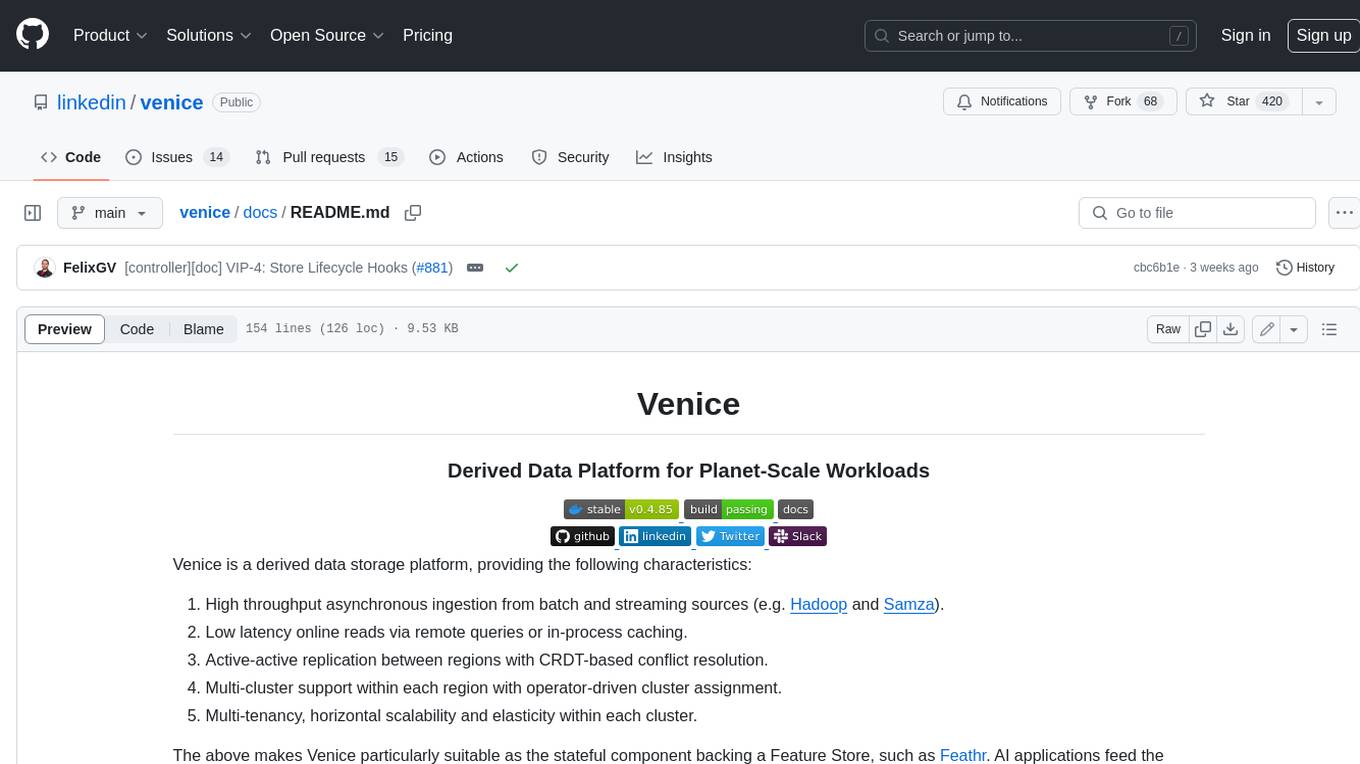
venice
Venice is a derived data storage platform, providing the following characteristics: 1. High throughput asynchronous ingestion from batch and streaming sources (e.g. Hadoop and Samza). 2. Low latency online reads via remote queries or in-process caching. 3. Active-active replication between regions with CRDT-based conflict resolution. 4. Multi-cluster support within each region with operator-driven cluster assignment. 5. Multi-tenancy, horizontal scalability and elasticity within each cluster. The above makes Venice particularly suitable as the stateful component backing a Feature Store, such as Feathr. AI applications feed the output of their ML training jobs into Venice and then query the data for use during online inference workloads.
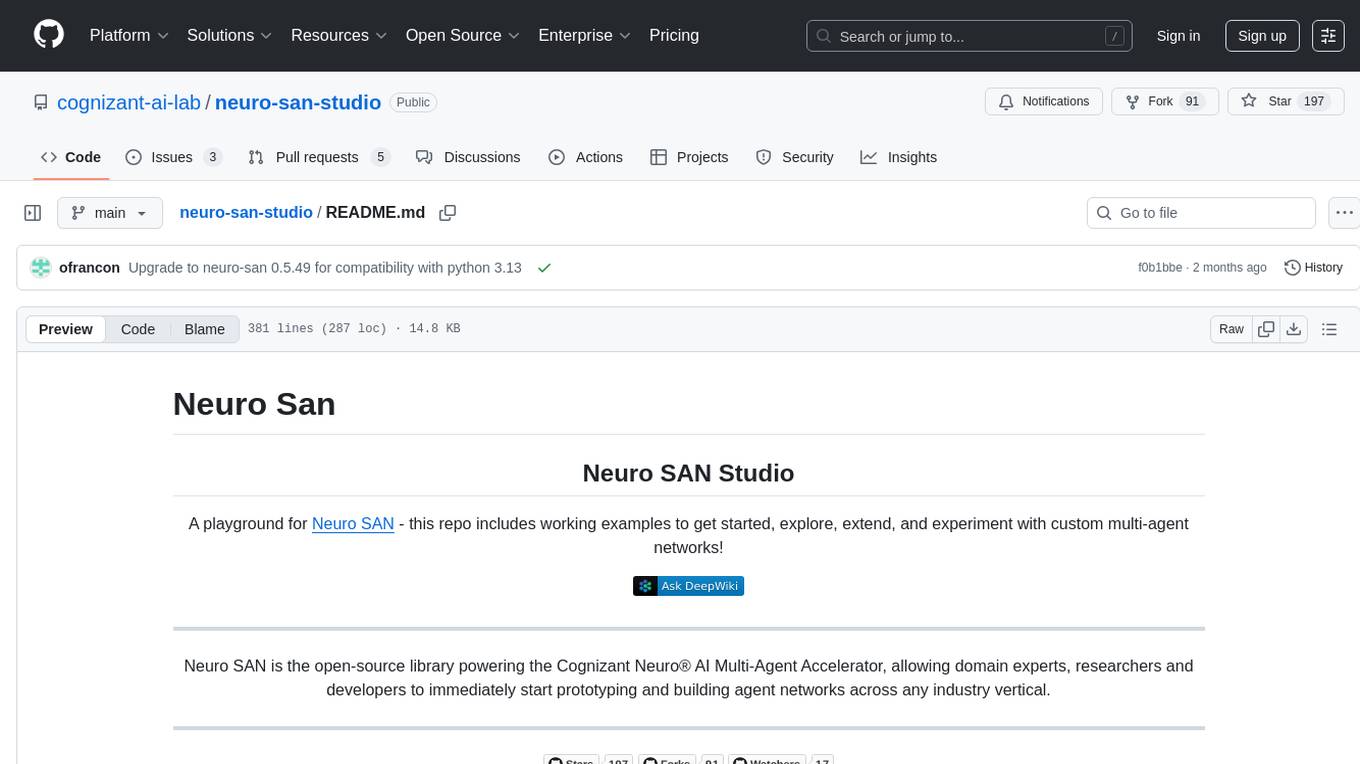
neuro-san-studio
Neuro SAN Studio is an open-source library for building agent networks across various industries. It simplifies the development of collaborative AI systems by enabling users to create sophisticated multi-agent applications using declarative configuration files. The tool offers features like data-driven configuration, adaptive communication protocols, safe data handling, dynamic agent network designer, flexible tool integration, robust traceability, and cloud-agnostic deployment. It has been used in various use-cases such as automated generation of multi-agent configurations, airline policy assistance, banking operations, market analysis in consumer packaged goods, insurance claims processing, intranet knowledge management, retail operations, telco network support, therapy vignette supervision, and more.
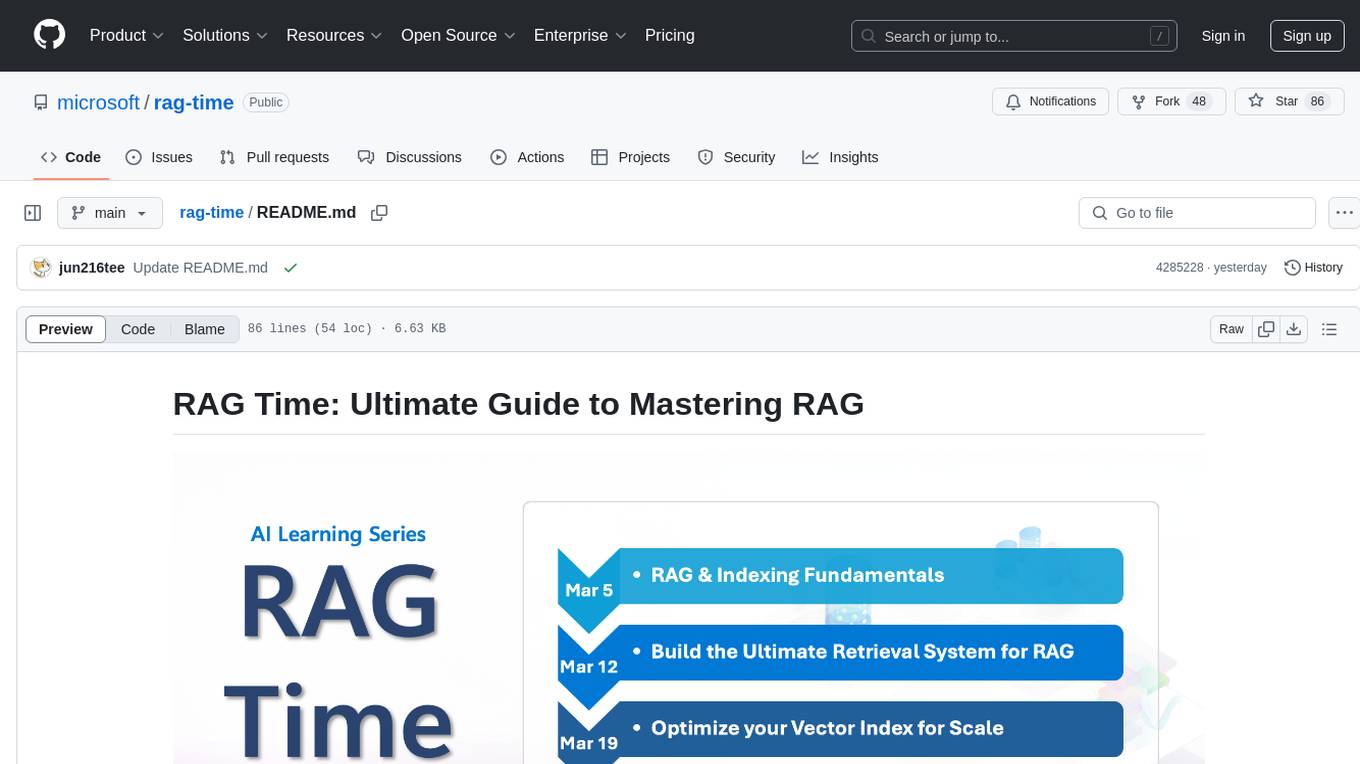
rag-time
RAG Time is a 5-week AI learning series focusing on Retrieval-Augmented Generation (RAG) concepts. The repository contains code samples, step-by-step guides, and resources to help users master RAG. It aims to teach foundational and advanced RAG concepts, demonstrate real-world applications, and provide hands-on samples for practical implementation.
For similar tasks
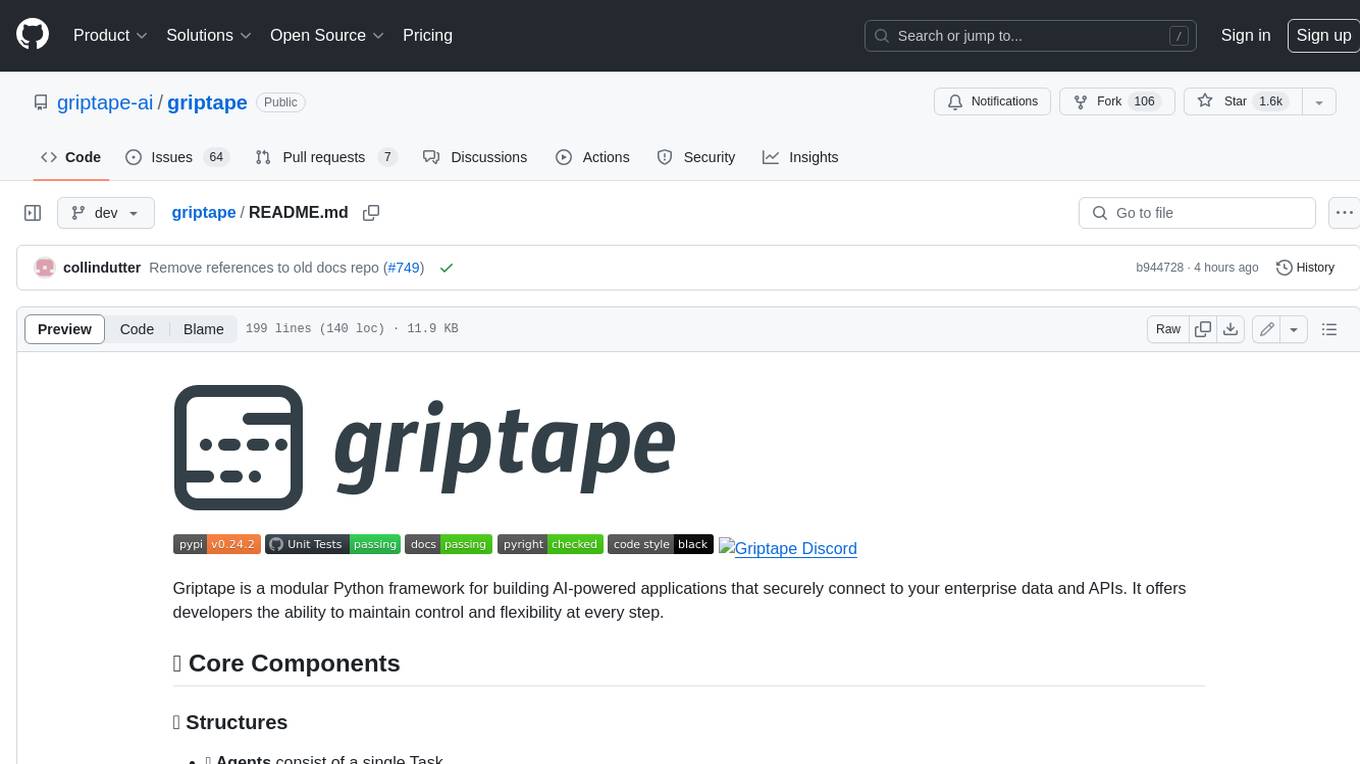
griptape
Griptape is a modular Python framework for building AI-powered applications that securely connect to your enterprise data and APIs. It offers developers the ability to maintain control and flexibility at every step. Griptape's core components include Structures (Agents, Pipelines, and Workflows), Tasks, Tools, Memory (Conversation Memory, Task Memory, and Meta Memory), Drivers (Prompt and Embedding Drivers, Vector Store Drivers, Image Generation Drivers, Image Query Drivers, SQL Drivers, Web Scraper Drivers, and Conversation Memory Drivers), Engines (Query Engines, Extraction Engines, Summary Engines, Image Generation Engines, and Image Query Engines), and additional components (Rulesets, Loaders, Artifacts, Chunkers, and Tokenizers). Griptape enables developers to create AI-powered applications with ease and efficiency.
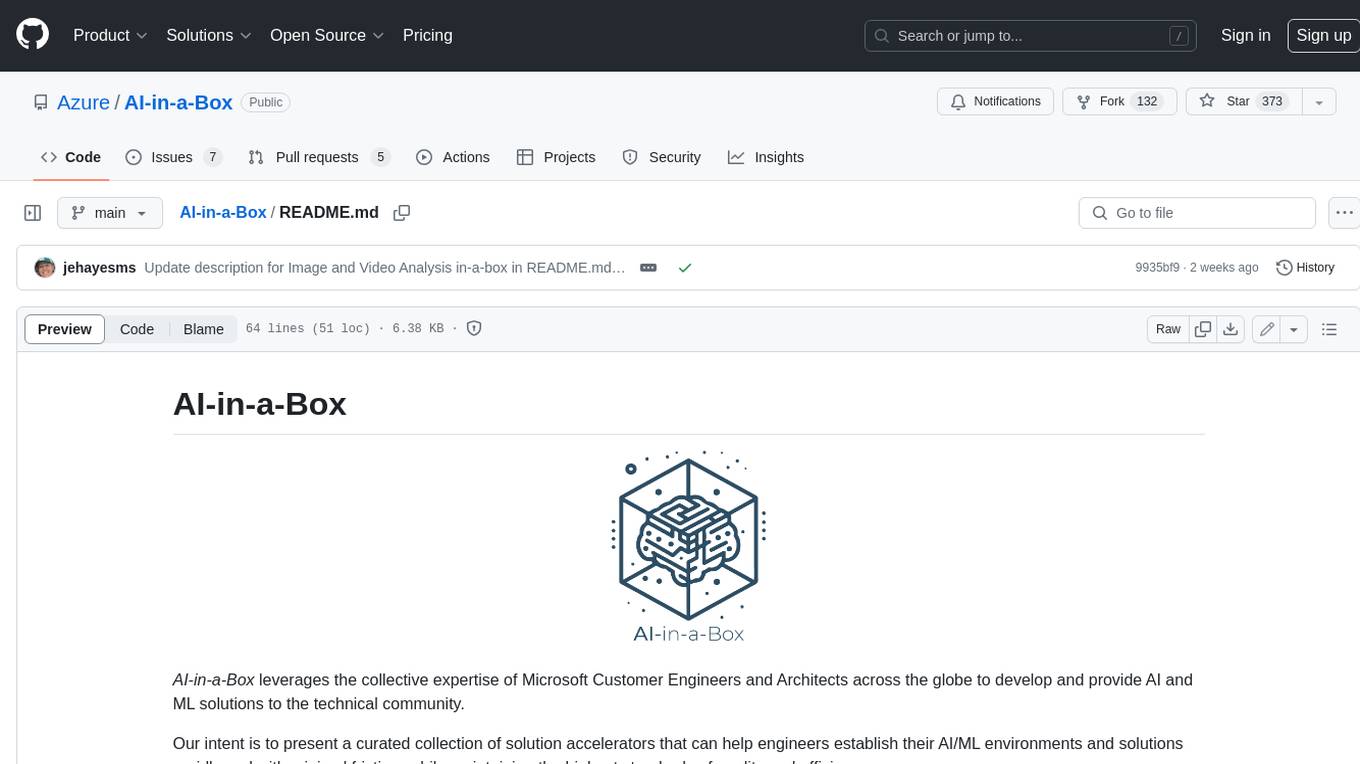
AI-in-a-Box
AI-in-a-Box is a curated collection of solution accelerators that can help engineers establish their AI/ML environments and solutions rapidly and with minimal friction, while maintaining the highest standards of quality and efficiency. It provides essential guidance on the responsible use of AI and LLM technologies, specific security guidance for Generative AI (GenAI) applications, and best practices for scaling OpenAI applications within Azure. The available accelerators include: Azure ML Operationalization in-a-box, Edge AI in-a-box, Doc Intelligence in-a-box, Image and Video Analysis in-a-box, Cognitive Services Landing Zone in-a-box, Semantic Kernel Bot in-a-box, NLP to SQL in-a-box, Assistants API in-a-box, and Assistants API Bot in-a-box.
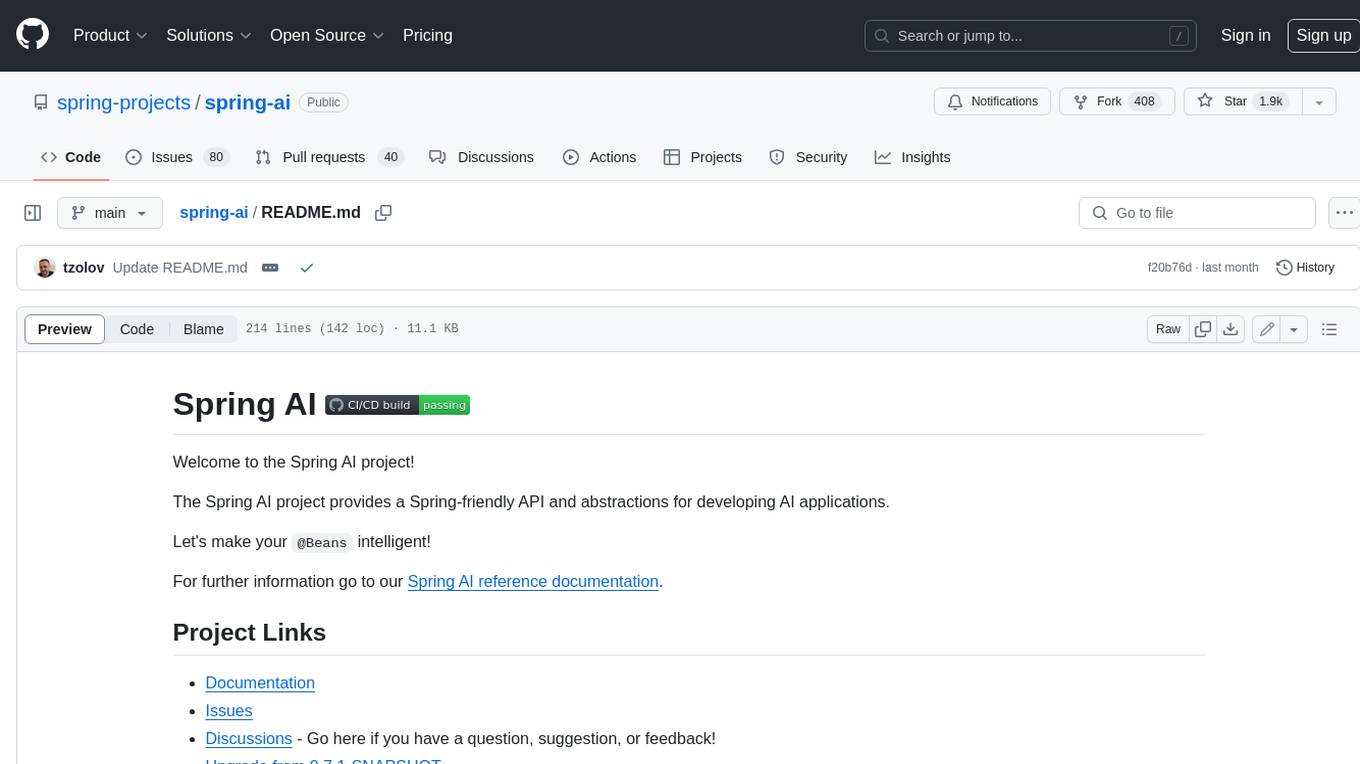
spring-ai
The Spring AI project provides a Spring-friendly API and abstractions for developing AI applications. It offers a portable client API for interacting with generative AI models, enabling developers to easily swap out implementations and access various models like OpenAI, Azure OpenAI, and HuggingFace. Spring AI also supports prompt engineering, providing classes and interfaces for creating and parsing prompts, as well as incorporating proprietary data into generative AI without retraining the model. This is achieved through Retrieval Augmented Generation (RAG), which involves extracting, transforming, and loading data into a vector database for use by AI models. Spring AI's VectorStore abstraction allows for seamless transitions between different vector database implementations.
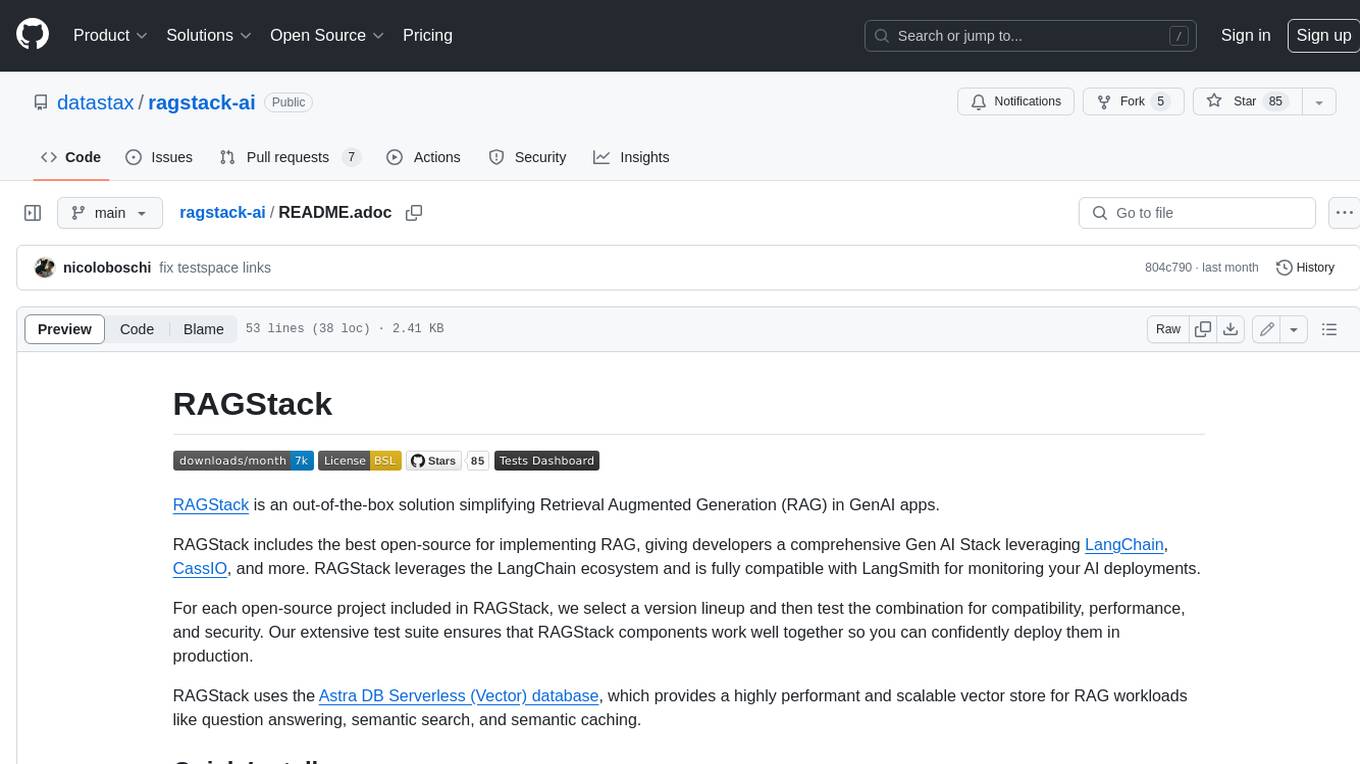
ragstack-ai
RAGStack is an out-of-the-box solution simplifying Retrieval Augmented Generation (RAG) in GenAI apps. RAGStack includes the best open-source for implementing RAG, giving developers a comprehensive Gen AI Stack leveraging LangChain, CassIO, and more. RAGStack leverages the LangChain ecosystem and is fully compatible with LangSmith for monitoring your AI deployments.
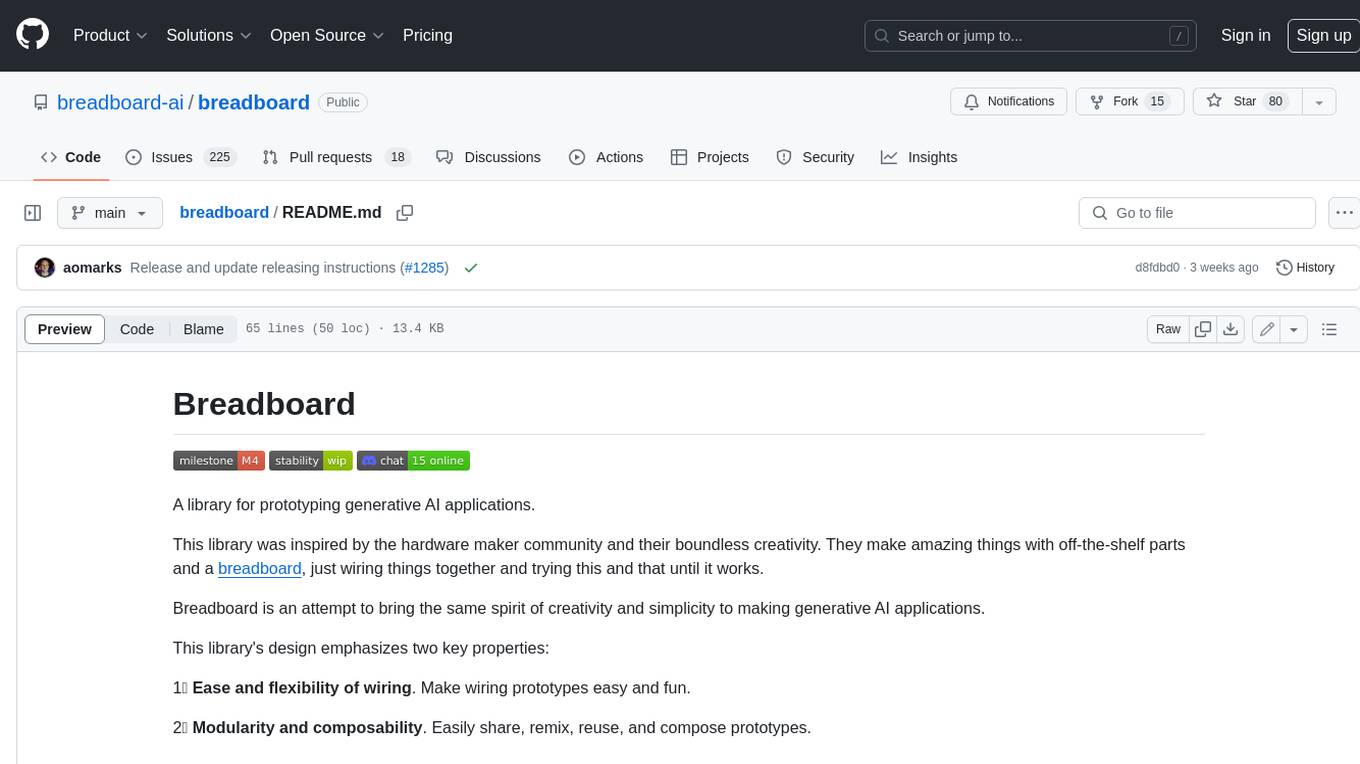
breadboard
Breadboard is a library for prototyping generative AI applications. It is inspired by the hardware maker community and their boundless creativity. Breadboard makes it easy to wire prototypes and share, remix, reuse, and compose them. The library emphasizes ease and flexibility of wiring, as well as modularity and composability.
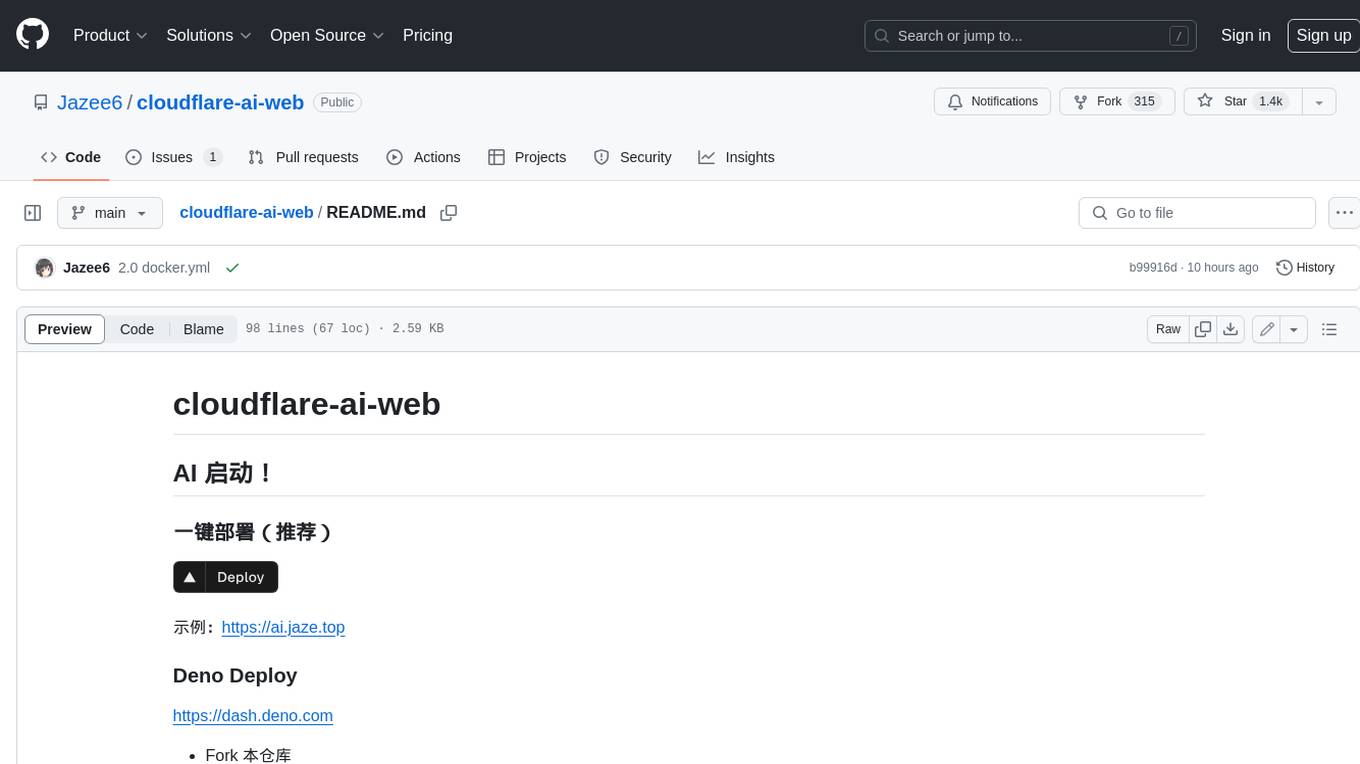
cloudflare-ai-web
Cloudflare-ai-web is a lightweight and easy-to-use tool that allows you to quickly deploy a multi-modal AI platform using Cloudflare Workers AI. It supports serverless deployment, password protection, and local storage of chat logs. With a size of only ~638 kB gzip, it is a great option for building AI-powered applications without the need for a dedicated server.
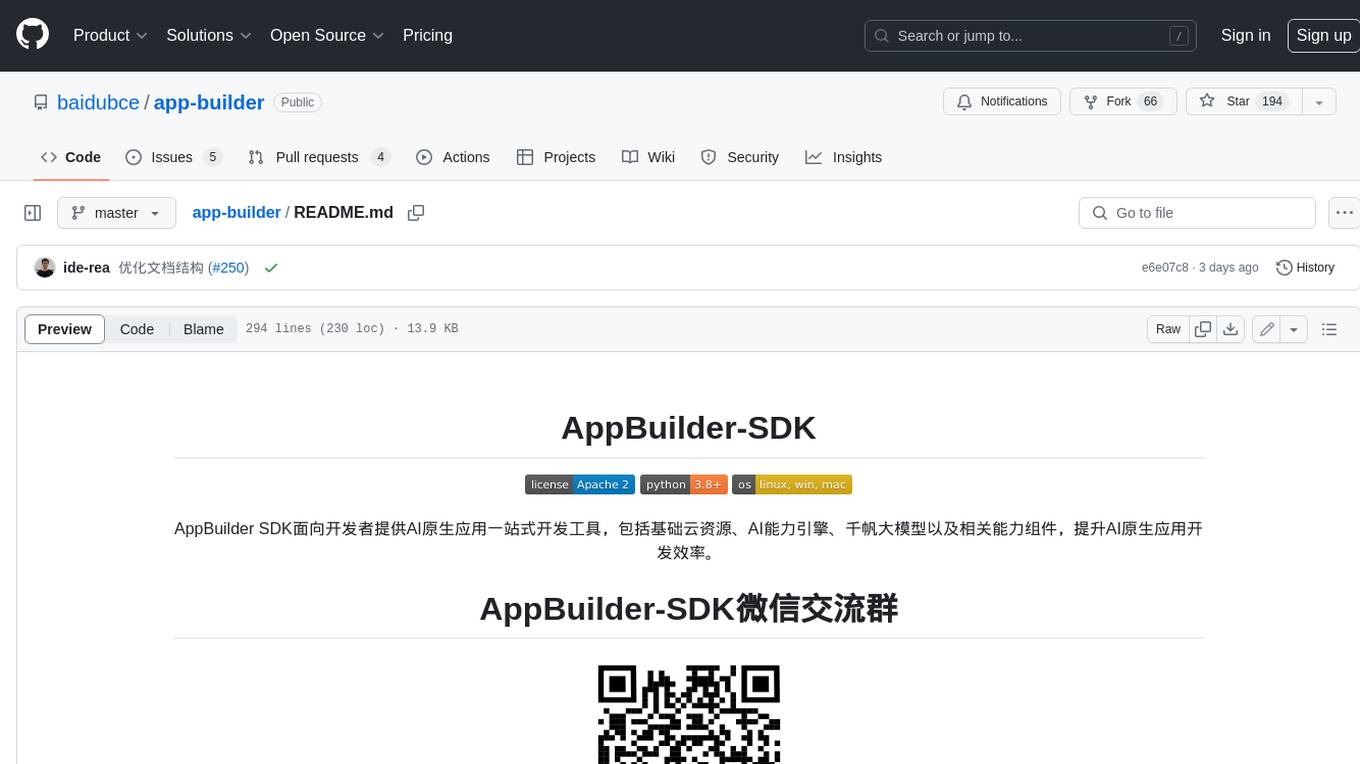
app-builder
AppBuilder SDK is a one-stop development tool for AI native applications, providing basic cloud resources, AI capability engine, Qianfan large model, and related capability components to improve the development efficiency of AI native applications.

cookbook
This repository contains community-driven practical examples of building AI applications and solving various tasks with AI using open-source tools and models. Everyone is welcome to contribute, and we value everybody's contribution! There are several ways you can contribute to the Open-Source AI Cookbook: Submit an idea for a desired example/guide via GitHub Issues. Contribute a new notebook with a practical example. Improve existing examples by fixing issues/typos. Before contributing, check currently open issues and pull requests to avoid working on something that someone else is already working on.
For similar jobs

sweep
Sweep is an AI junior developer that turns bugs and feature requests into code changes. It automatically handles developer experience improvements like adding type hints and improving test coverage.

teams-ai
The Teams AI Library is a software development kit (SDK) that helps developers create bots that can interact with Teams and Microsoft 365 applications. It is built on top of the Bot Framework SDK and simplifies the process of developing bots that interact with Teams' artificial intelligence capabilities. The SDK is available for JavaScript/TypeScript, .NET, and Python.

ai-guide
This guide is dedicated to Large Language Models (LLMs) that you can run on your home computer. It assumes your PC is a lower-end, non-gaming setup.

classifai
Supercharge WordPress Content Workflows and Engagement with Artificial Intelligence. Tap into leading cloud-based services like OpenAI, Microsoft Azure AI, Google Gemini and IBM Watson to augment your WordPress-powered websites. Publish content faster while improving SEO performance and increasing audience engagement. ClassifAI integrates Artificial Intelligence and Machine Learning technologies to lighten your workload and eliminate tedious tasks, giving you more time to create original content that matters.

chatbot-ui
Chatbot UI is an open-source AI chat app that allows users to create and deploy their own AI chatbots. It is easy to use and can be customized to fit any need. Chatbot UI is perfect for businesses, developers, and anyone who wants to create a chatbot.

BricksLLM
BricksLLM is a cloud native AI gateway written in Go. Currently, it provides native support for OpenAI, Anthropic, Azure OpenAI and vLLM. BricksLLM aims to provide enterprise level infrastructure that can power any LLM production use cases. Here are some use cases for BricksLLM: * Set LLM usage limits for users on different pricing tiers * Track LLM usage on a per user and per organization basis * Block or redact requests containing PIIs * Improve LLM reliability with failovers, retries and caching * Distribute API keys with rate limits and cost limits for internal development/production use cases * Distribute API keys with rate limits and cost limits for students

uAgents
uAgents is a Python library developed by Fetch.ai that allows for the creation of autonomous AI agents. These agents can perform various tasks on a schedule or take action on various events. uAgents are easy to create and manage, and they are connected to a fast-growing network of other uAgents. They are also secure, with cryptographically secured messages and wallets.

griptape
Griptape is a modular Python framework for building AI-powered applications that securely connect to your enterprise data and APIs. It offers developers the ability to maintain control and flexibility at every step. Griptape's core components include Structures (Agents, Pipelines, and Workflows), Tasks, Tools, Memory (Conversation Memory, Task Memory, and Meta Memory), Drivers (Prompt and Embedding Drivers, Vector Store Drivers, Image Generation Drivers, Image Query Drivers, SQL Drivers, Web Scraper Drivers, and Conversation Memory Drivers), Engines (Query Engines, Extraction Engines, Summary Engines, Image Generation Engines, and Image Query Engines), and additional components (Rulesets, Loaders, Artifacts, Chunkers, and Tokenizers). Griptape enables developers to create AI-powered applications with ease and efficiency.







